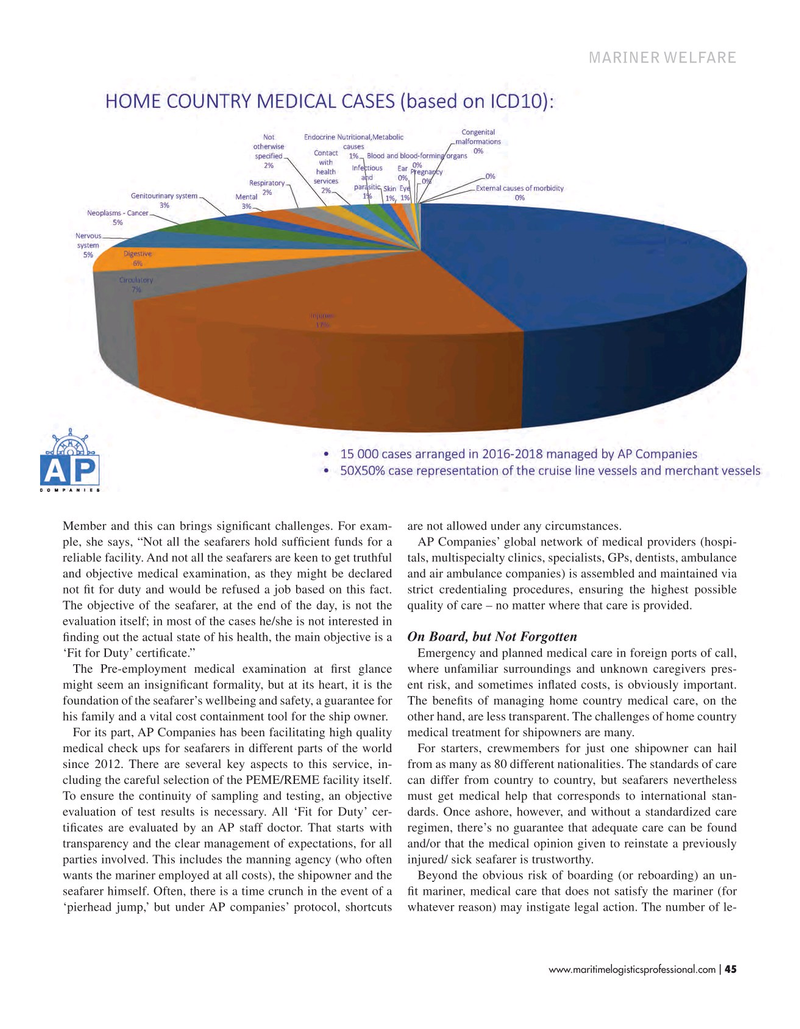
Page 45: of Maritime Logistics Professional Magazine (Sep/Oct 2019)
Energy Ports Oil-Gas-LNG
Read this page in Pdf, Flash or Html5 edition of Sep/Oct 2019 Maritime Logistics Professional Magazine
MARINER WELFARE
Member and this can brings signifcant challenges. For exam- are not allowed under any circumstances.
ple, she says, “Not all the seafarers hold suffcient funds for a AP Companies’ global network of medical providers (hospi- reliable facility. And not all the seafarers are keen to get truthful tals, multispecialty clinics, specialists, GPs, dentists, ambulance and objective medical examination, as they might be declared and air ambulance companies) is assembled and maintained via not ft for duty and would be refused a job based on this fact. strict credentialing procedures, ensuring the highest possible
The objective of the seafarer, at the end of the day, is not the quality of care – no matter where that care is provided.
evaluation itself; in most of the cases he/she is not interested in fnding out the actual state of his health, the main objective is a On Board, but Not Forgotten ‘Fit for Duty’ certifcate.” Emergency and planned medical care in foreign ports of call,
The Pre-employment medical examination at frst glance where unfamiliar surroundings and unknown caregivers pres- might seem an insignifcant formality, but at its heart, it is the ent risk, and sometimes infated costs, is obviously important. foundation of the seafarer’s wellbeing and safety, a guarantee for The benefts of managing home country medical care, on the his family and a vital cost containment tool for the ship owner. other hand, are less transparent. The challenges of home country
For its part, AP Companies has been facilitating high quality medical treatment for shipowners are many. medical check ups for seafarers in different parts of the world For starters, crewmembers for just one shipowner can hail since 2012. There are several key aspects to this service, in- from as many as 80 different nationalities. The standards of care cluding the careful selection of the PEME/REME facility itself. can differ from country to country, but seafarers nevertheless
To ensure the continuity of sampling and testing, an objective must get medical help that corresponds to international stan- evaluation of test results is necessary. All ‘Fit for Duty’ cer- dards. Once ashore, however, and without a standardized care tifcates are evaluated by an AP staff doctor. That starts with regimen, there’s no guarantee that adequate care can be found transparency and the clear management of expectations, for all and/or that the medical opinion given to reinstate a previously parties involved. This includes the manning agency (who often injured/ sick seafarer is trustworthy. wants the mariner employed at all costs), the shipowner and the Beyond the obvious risk of boarding (or reboarding) an un- seafarer himself. Often, there is a time crunch in the event of a ft mariner, medical care that does not satisfy the mariner (for ‘pierhead jump,’ but under AP companies’ protocol, shortcuts whatever reason) may instigate legal action. The number of le- www.maritimelogisticsprofessional.com 45
I

 44
44

 46
46
